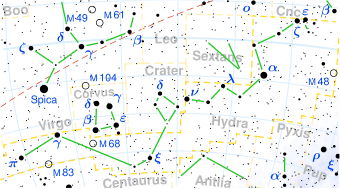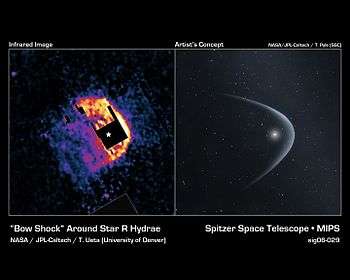R Hydrae
 | |
| Observation data Epoch J2000 Equinox J2000 | |
|---|---|
| Constellation | Hydra |
| Right ascension | 13h 29m 42.77203s[1] |
| Declination | −23° 16′ 52.6972″[1] |
| Apparent magnitude (V) | 3.5 to 10.9 (variable)[2] |
| Characteristics | |
| Spectral type | M6e/M9e:[3] |
| B−V color index | 1.317±0.254[4] |
| Variable type | Mira[2] (period 388.87 days) |
| Astrometry | |
| Radial velocity (Rv) | −10.0±0.6[5] km/s |
| Proper motion (μ) | RA: −46.660[1] mas/yr Dec.: +7.984[1] mas/yr |
| Parallax (π) | 4.4682 ± 0.8942[1] mas |
| Distance | approx. 700 ly (approx. 220 pc) |
| Absolute magnitude (MV) | +0.95[4] |
| Details | |
| Mass | 2[6] M☉ |
| Radius | 460[6]-631[7] (variable) R☉ |
| Luminosity | 7,375[7]-10,000[6] (variable) L☉ |
| Temperature | 2,128[7]-2,830[6] K |
| Other designations | |
| Database references | |
| SIMBAD | data |
R Hydrae, also known as R Hya,[2] is a Mira-type variable star in the constellation Hydra.[2][8]
The magnitude of R Hydrae varies over a period of 389 days, between 3.5 and 10.9. The period of R Hydrae changes slowly.
At maximum brightness the star can be seen with the naked eye, while at minimum a telescope of at least 5 cm is needed.
R Hydrae is approximately 700 light years from Earth. Its spectral class is M6e/M9e:.[8]
References
- 1 2 3 4 5 Brown, A. G. A.; et al. (Gaia collaboration) (August 2018). "Gaia Data Release 2: Summary of the contents and survey properties". Astronomy & Astrophysics. 616. A1. arXiv:1804.09365. Bibcode:2018A&A...616A...1G. doi:10.1051/0004-6361/201833051.
- 1 2 3 4 AAVSO
- ↑ Keenan, Philip C.; Garrison, Robert F.; Deutsch, Armin J. (1974). "Revised Catalog of Spectra of Mira Variables of Types ME and Se". Astrophysical Journal Supplement. 28: 271. Bibcode:1974ApJS...28..271K. doi:10.1086/190318.
- 1 2 Anderson, E.; Francis, Ch. (2012), "XHIP: An extended hipparcos compilation", Astronomy Letters, 38 (5): 331, arXiv:1108.4971, Bibcode:2012AstL...38..331A, doi:10.1134/S1063773712050015.
- ↑ Gontcharov, G. A. (2006). "Pulkovo Compilation of Radial Velocities for 35 495 Hipparcos stars in a common system". Astronomy Letters. 32 (11): 759. arXiv:1606.08053. Bibcode:2006AstL...32..759G. doi:10.1134/S1063773706110065.
- 1 2 3 4 Zijlstra, A. A.; Bedding, T. R.; Mattei, J. A. (2002). "The evolution of the Mira variable R Hydrae". Monthly Notices of the Royal Astronomical Society. 334 (3): 498. arXiv:astro-ph/0203328. Bibcode:2002MNRAS.334..498Z. doi:10.1046/j.1365-8711.2002.05467.x.
- 1 2 3 De Beck, E.; Decin, L.; De Koter, A.; Justtanont, K.; Verhoelst, T.; Kemper, F.; Menten, K. M. (2010). "Probing the mass-loss history of AGB and red supergiant stars from CO rotational line profiles. II. CO line survey of evolved stars: derivation of mass-loss rate formulae". Astronomy and Astrophysics. 523: A18. arXiv:1008.1083. Bibcode:2010A&A...523A..18D. doi:10.1051/0004-6361/200913771. A18.
- 1 2 3 "V* R Hya". SIMBAD. Centre de données astronomiques de Strasbourg.
- ↑ Spitzer Science Center Press Release: Red Giant Plunging Through Space Archived 2007-05-13 at the Wayback Machine.
External links
This article is issued from
Wikipedia.
The text is licensed under Creative Commons - Attribution - Sharealike.
Additional terms may apply for the media files.
